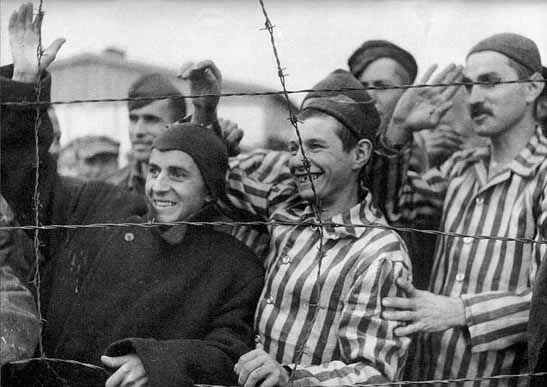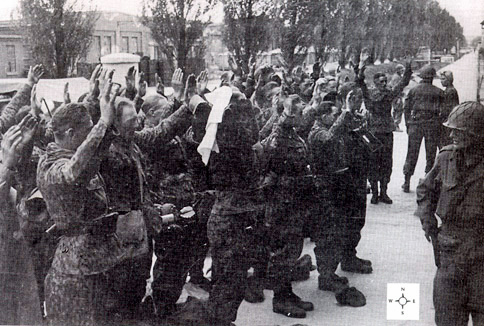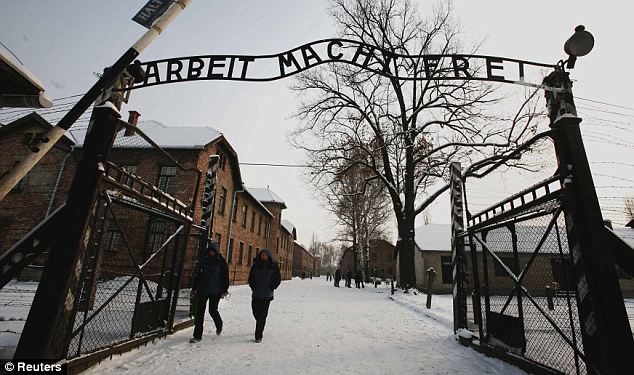The anniversary of the liberation of Dachau on April 29, 1945 will be coming up soon, and there will be lots of news articles about the camp. There might also be some news about the Herbertshausen shooting range, where Soviet Prisoners of War were allegedly shot for target practice.

Rifle range at Herbertshausen Photo credit: Donald E. Jackson
There is now a Memorial to these POWs, which you can read about at http://www.kz-gedenkstaette-dachau.de/news-hebertshausen.html
This quote is from the website, cited above:
On June 22, 2011 a commemorative service was held to mark the burial of the mortal remains of unknown Soviet prisoners of war on the former “SS shooting range Hebertshausen”. In 1941-1942 SS units of the Dachau concentration camp shot dead around 4,500 Soviet prisoners, contravening international law – officers, Communist officials, intellectuals, and Jews. A memorial now commemorates the unknown murdered victims at the site of the crime. Speeches were held by Dr. Gabriele Hammermann, Head of the Dachau Concentration Camp Memorial Site, Karl Freller, MP, director of the Bavarian Memorial Foundation, Andrei Grozow, Consul General of the Russian Federation, Alexander Ganevich, Consul General of the Republic of Belarus, Charlotte Knobloch, president of the Jewish Community of Munich and Upper Bavaria. Subsequently, representatives of the Jewish, Russian Orthodox, Catholic, Protestant and Islamic religious communities said funeral prayers in memory of the unknown victims.

Memorial to the murdered Soviet POWs at Herbertshausen
Wikipedia has a page about the Herbertshausen Memorial site at http://wikimapia.org/22774181/Memorial-to-the-murdered-Soviet-soldiers
This quote is from Wikipedia:
Some 4,000 imprisoned Soviet soldiers were executed there between 1941 and 1945. These murders were a clear violation of the provisions laid down in the Geneva Convention for prisoners of war. The SS used the cynical term “special treatment” for these criminal executions. The first executions of the Soviet prisoners of war at the Hebertshausen shooting range took place on November 25 1941.
The prisoners brought to Dachau for execution were not recorded in the concentration camp files. Today, an arduous evaluation of the lists and statistics from the prisoner camps at Hammelburg in the Rhone, Nuremberg-Langwasser, and Moosburg on the Isar is trying to obtain a complete record of the names.
Alert readers may have noticed that I used the word “allegedly” in the first sentence of my blog post today. Surely, there must be plenty of proof that Soviet Prisoners of War were used for target practice at Herbertshausen.
No, dear readers, I am sad to say that there is no proof whatsoever that Soviet POWs were shot at Herbertshausen.
This quote is from my own website scrapbookpages.com
After October 1941, captured Soviet soldiers were brought to Dachau. They were interrogated and 90 Russian officers, who were believed to be Communist Commissars, were executed on the direct orders of Adolf Hitler. This order was a violation of the Geneva Convention which set rules for the treatment of enemy POWs. Germany had signed the Convention but the Russians had declined to be a party to it.
During the American Military Tribunal for the staff members of the Dachau concentration camp, which was held in the Dachau complex in November 1945, the American prosecutor charged that several of the accused were guilty of “a common plan to violate the Laws and Usages of War” because they were present when 90 alleged Communist Commissars were executed at Dachau and did not try to stop the execution.
According to the American prosecutors at the American Military Tribunals held at Dachau, thousands of Russian POWs were taken to the SS shooting range at Herbertshausen, which was located in the Dachau suburb of Etzenhausen, where they were executed by a firing squad. The American defense attorneys at the American Military Tribunal for 40 Dachau staff members claimed that there was no proof that 5,000 Russian POWs were shot for target practice at Herbertshausen, as alleged by the prosecution.
I previously blogged about the trial of the German war criminals at the American Military Tribunal in which it was NOT proved that thousands of Soviet POWs at Dachau had been shot.
This quote is from my previous blog post at https://furtherglory.wordpress.com/2010/12/05/german-war-crimes-in-wwii-shooting-soviet-pows-for-target-practice/:
Major Boysen was an American defense attorney for Alex Piorkowski, a former Dachau Commandant, who was charged with war crimes in a subsidiary case of the Dachau trials. The prosecution’s case against Piorkowski was based on the testimony of 34 paid witnesses who were former prisoners at Dachau.
As the defense attorney for Piorkowski, Major Boysen pointed out that the prosecution’s allegation, that 6,000 to 8,000 Soviet POWs had been executed at Dachau in the spring of 1942, while Piorkowski was the Commandant, had not been proved in the main trial of Dachau camp personnel, yet it was put into evidence in the Piorkowski trial, along with other atrocities that had become matters of judicial notice and did not have to be proved again.
According to Joseph Halow, the court reporter who wrote the book Innocent at Dachau, Major Boysen concluded that he was of the “definite opinion that no such massacre occurred at Dachau as is factually stated to have taken place there in Prosecution Exhibit 1.”
After the first proceedings, against former Commandant Martin Weiss and 39 staff members at the Dachau camp, had been concluded, Major Boysen had learned that the Dachau railroad station commander, a man named Rohrmuehler, had witnessed the arrival of the trains bringing Soviet Prisoners of War to Dachau.
Rohrmuehler claimed that no more than 500 Russians had ever passed through the Dachau camp, and that the claim that 6,000 to 8,000 Soviet POWs had been massacred at Dachau was absurd. The testimony at the Dachau proceedings, concerning the killing of Soviet POWs, was in the form of affidavits and the witnesses had not been subjected to cross-examination in the courtroom, according to Court Reporter Joseph Halow.
The claim, by the Dachau railroad station man, does not make sense, since there were 3,900 Russians still in the Dachau camp when it was liberated, according to the Official Army Report. If 6,000 Russians had been used for target practice, as alleged by the prosecution, that would mean that at least 9,900 Russians had been brought to Dachau.
In spite of the fact that the shooting of Soviet POWs was never proved by the American Military Tribunal at Dachau, this story is still being told to tourists every day at the Dachau Memorial Site, along with the story that the shower room at Dachau is a gas chamber that was used to kill a few prisoners at Dachau, although not for mass gassing.
Dachau is not the only place where tourists are told that the SS shot prisoners for target practice. When I visited the Little Fortress, across the road from the Theresienstadt ghetto, I was told that prisoners who had been condemned to death were used for target practice.
The photograph below shows the place where prisoners were executed in the Small Fortress at Theresienstadt. One of the fortification walls is in the background and the spot where the condemned prisoner stood is in the center of the picture. The concrete form in the foreground was one of three places, under a free-standing roof, from which the firing squad would shoot while in a prone position.
According to a small booklet which I purchased at the Museum, between 250 and 300 of the 32,000 prisoners, who were inmates at the Small Fortress, were executed. The first recorded execution was on May 11, 1943 when a leader of the Communist resistance, Frantisek Prokop, was shot at the firing range.

Firing range at the Small Fortresss at Theresienstadt





































